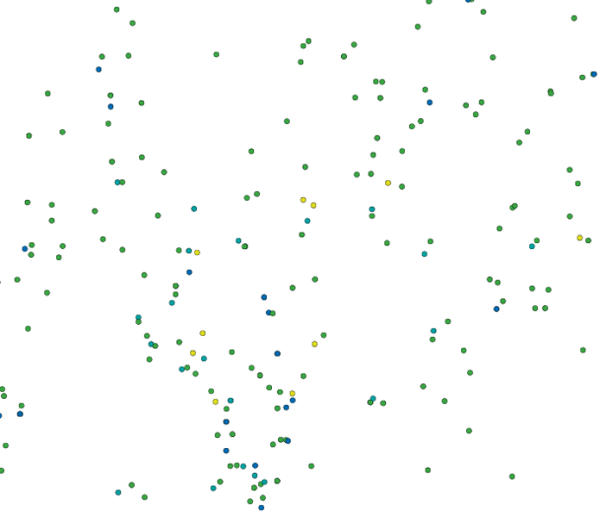Type of resources
Available actions
Topics
Keywords
Contact for the resource
Provided by
Years
Formats
Representation types
Update frequencies
status
Service types
Scale
Resolution
-
The EMODnet (European Marine Observation and Data network) Geology project collects and harmonizes marine geological data from the European sea areas to support decision making and sustainable marine spatial planning. The partnership includes 39 marine organizations from 30 countries. The partners, mainly from the marine departments of the geological surveys of Europe (through the Association of European Geological Surveys-EuroGeoSurveys), have assembled marine geological information at various scales from all European sea areas (e.g. the White Sea, Baltic Sea, Barents Sea, the Iberian Coast, and the Mediterranean Sea within EU waters). This dataset includes EMODnet seabed substrate maps at a scale of 1:15 000 from the European marine areas. Traditionally, European countries have conducted their marine geological surveys according to their own national standards and classified substrates on the grounds of their national classification schemes. These national classifications are harmonised into a shared EMODnet schema using Folk's sediment triangle with a hierarchy of 16, 7 and 5 substrate classes. The data describes the seabed substrate from the uppermost 30 cm of the sediment column. Further information about the EMODnet Geology project is available on the portal (http://www.emodnet-geology.eu/).
-

Location (x,y) and name of educational institutions. Statistical reference year 2024. Data includes a location and a name of every comprehensive and upper secondary level schools in Finland. The source of data is the yearly updated register of educational institutions (https://tilastokeskus.fi/tup/oppilaitosrekisteri/index_en.html) which is maintained by Statistics Finland. An educational institution is defined as an administrative unit as such not the school building or the operating place. Coordinates are mostly accurate based on the centroid of the building althought there exists some educational institutions with estimated coordinates. Estimations are based to the street address of the educational institutions. Validity (OLO): 0 = Valid 1 = Closed down during the statistical year 2 = Merged with another educational institution during the statistical year 3 = Educational institution removed from the educational institutions of the education system 6 = Educational institution had no activity during the statistical year 7 = Technical removal Type of educational institute (OLTYP): 11 = Comprehensive schools 12 = Comprehensive school level special education schools 15 = Upper secondary general schools 19 = Comprehensive and upper secondary level schools The general Terms of Use must be observed when using the data: http://tilastokeskus.fi/org/lainsaadanto/copyright_en.html. In addition to the national version, an INSPIRE information product is also available from the data.
-
This dataset contains borders of the HELCOM MPAs (former Baltic Sea Protected Areas (BSPAs). The dataset has been compiled from data submitted by HELCOM Contracting Parties. It includes the borders of designated HELCOM MPAs stored in the http://mpas.helcom.fi. The designation is based on the HELCOM Recommendation 15/5 (1994). The dataset displays all designated or managed MPAs as officially reported to HELCOM by the respective Contracting Party. The latest related HELCOM publication based on MPA related data is http://www.helcom.fi/Lists/Publications/BSEP148.pdf The dataset contains the following information: MPA_ID: Unique ID of the MPA as used in HELCOM Marine Protected Areas database Name: Name of the MPA Country: Country where MPA is located Site_link: Direct link to site's fact sheet in the http://mpas.helcom.fi where additional information is available MPA_status: Management status of the MPA Date_est: Establishment date of the MPA Year_est: Establishment year of the MPA
-
Ortokuvien ja korkeusmallien kyselypalvelun (WCS) kautta voit hakea rasterimuotoisia ortokuvia ja korkeusmalleja. Palvelussa voit poimia haluttuja paloja aineistoista omalla aluerajauksellasi. Ortokuvien osalta palvelu sisältää Maanmittauslaitoksen väri-, vääräväri- ja mustavalkoisia ortokuvia eri vuosilta. Korkeusmalli on 2 m korkeusmallia, joka on tuotettu laserkeilausaineiston pohjalta. Korkeusmallia pystyy hakemaan palvelusta myös karkeammilla kuin 2m resoluutioilla. Tarjolla ovat seuraavat resoluutiot: 2 m, 4 m, 8 m, 16 m, 32 m, 64 m, 128 m, 256 m ja 512 m. Ortokuvat ovat saatavilla palvelusta GeoTIFF-formaatissa ja korkeusmalli GeoTIFF- tai ASCII Grid -formaatissa. Palvelun käyttäminen edellyttää perehtyneisyyttä paikkatietorajapintojen ohjelmalliseen hyödyntämiseen. Yksittäisten latausten tekeminen onnistuu myös selaimella. Ladatut tiedostot saat auki ja voit jatkokäsitellä paikkatieto-ohjelmalla. Toistaiseksi palvelua ei pysty käyttämään esimerkiksi QGIS -ohjelmalla. Aineistot ovat Maanmittauslaitoksen avoimen tietoaineiston Nimeä CC 4.0 -lisenssin alaisia. Palvelu tarjotaan avoimena rajapintana, jonka käyttö on maksutonta. Käyttäjä tunnistetaan API-avaimella. Lue lisää Maanmittauslaitoksen avoimen rajapinnan käyttöehdoista ja API-avaimen luomisesta ja käyttämisestä. https://www.maanmittauslaitos.fi/rajapinnat/api-avaimen-ohje https://www.maanmittauslaitos.fi/ortokuvien-ja-korkeusmallien-kyselypalvelu
-
Statistics Finland's Web Service is a WMS interface service through which the following data required by INSPIRE and national legislation on geographic information are available: 1) Statistical units: Regional divisions (municipality, major region, region, sub-regional unit, Regional State Administrative Agency (AVI), Centre for Economic Development, Transport and the Environment (ELY), electoral district) and grid 1 km x 1 km. 2) Non-profit and public services: Educational institutions (comprehensive schools, upper secon-dary general schools) 3) Production and industrial facilities: Production and industrial facilities 4) Population distribution by the regional divisions used in statistics and by 1 km x 1 km grids. Other data published: - Open data by postal code area (Paavo) - Population distribution by 5 km x 5 km grids The data are administered by Statistics Finland. The service is free of charge and does not require authentication or identification with a user ID and password. The general Terms of Use must be observed when using the data: http://tilastokeskus.fi/org/lainsaadanto/copyright_en.html.
-
Conditionality refers to the basic requirements that farmers' payments are conditional upon. Conditionality requirements are the baseline level for which you do not receive a separate payment. Aid is only granted for activities that go beyond the conditionality requirements. Conditionality consists of GAEC, statutory management requirements and social conditionality. Statutory management requirements relate to environmental issues, public health, i.e. food and feed safety, plant health and animal health and welfare. All conditionality requirements are described in this guide. When you apply for farmer payments, you agree to comply with the conditionality requirements. A landscape feature can be a tree, group of trees, transplanted block or other similar natural feature that is protected for its beauty, rarity, landscape significance, scientific value or other similar reason. Qualifying landscape features are sites protected under Article 95 of the Nature Conservation Act (9/2023) and located within a base parcel, on the periphery of a base parcel or in the area between adjacent base parcels. Protected sites must always be preserved and must not be damaged or removed. If a protected landscape feature is located on an area of 0,2 ha or less, it may be included in the area of the base parcel. If you wish to include a protected site in the eligible area, please declare the sites on the Food Agency's form 442 when applying for arable aid. The area of a landscape feature will only become part of the eligible area of the base parcel in the year following the submission of the declaration. Who makes conservation decisions on sites? If the site to be protected is located on private land, the decision to protect the site is taken by the municipality's environmental protection authority. The municipality is also responsible for marking the site on the land. On private land, protection is only granted on application or with the consent of the landowner. On application by the owner or on a proposal from the ELY Centre, the municipality may terminate the protection of a landscape feature if there are no longer grounds for protecting it or if the protection prevents the implementation of a project or plan of public interest. The application must be accompanied by the opinion of the ELY Centre. If the matter has been initiated on the basis of a proposal from the ELY Centre, the owner of the site must be given the opportunity to be heard. For more information: https://www.ruokavirasto.fi/tuet/maatalous/perusehdot/ehdollisuus/ehdollisuuden-opas/ehdollisuuden-opas-2025/
-
KUVAUS: Aineisto sisältää raitiotien katusuunnitelmien reitit Tampereen alueelta sekä linkkejä suunnitelmapiirustuksiin. KATTAVUUS: Kaikille käyttäjille Oskari-karttapalvelussa. PÄIVITYS: Aineistoa päivitetään tarpeen mukaan (ylläpito jatkuvaa). YLLÄPITOSOVELLUS: PostgreSQL-tietokanta ja QGIS-ohjelmisto. KOORDINAATTIJÄRJESTELMÄ: Aineisto tallennetaan ETRS-GK24FIN (EPSG:3878) tasokoordinaattijärjestelmässä. GEOMETRIA: vektori (viiva) SAATAVUUS: Aineisto on saatavilla WFS-rajapinnalta Tampereen kaupungin sisäiseen käyttöön. JULKISUUS: Kaikille käyttäjille Oskari-karttapalvelussa. AINEISTOSTA VASTAAVA TAHO: Tampereen kaupunki, Kuntatekniikan suunnittelu
-
NLS-FI INSPIRE View Service for Hydrography Theme is an INSPIRE compliant Web Map Service. It contains the following harmonized INSPIRE map layers: Land-water Boundary, Waterbodies, Man-made Objects, Hydro Point of Interest. The service is based on the NLS-FI INSPIRE Hydrography Physical Waters dataset. The dataset is administrated by the National Land Survey of Finland.
-
The EMODnet (European Marine Observation and Data network) Geology project collects and harmonizes marine geological data from the European sea areas to support decision making and sustainable marine spatial planning. The partnership includes 39 marine organizations from 30 countries. The partners, mainly from the marine departments of the geological surveys of Europe (through the Association of European Geological Surveys-EuroGeoSurveys), have assembled marine geological information at various scales from all European sea areas (e.g. the White Sea, Baltic Sea, Barents Sea, the Iberian Coast, and the Mediterranean Sea within EU waters). This dataset includes EMODnet seabed substrate maps at a scale of 1:20 000 from the European marine areas. Traditionally, European countries have conducted their marine geological surveys according to their own national standards and classified substrates on the grounds of their national classification schemes. These national classifications are harmonised into a shared EMODnet schema using Folk's sediment triangle with a hierarchy of 16, 7 and 5 substrate classes. The data describes the seabed substrate from the uppermost 30 cm of the sediment column. Further information about the EMODnet Geology project is available on the portal (http://www.emodnet-geology.eu/).
-

NLS-FI INSPIRE View Service for Administrative Units Theme is an INSPIRE compliant Web Map Service. It contains the following harmonized INSPIRE map layers: AdministrativeUnit, AdministrativeBoundary, Baseline, TerritorialSea, ExclusiveEconomicZone, MaritimeBoundary.InternalWaters, MaritimeBoundary.TerritorialSea ,MaritimeBoundary.ExclusiveEconomicZone. The service is based on the NLS-FI INSPIRE Administrative Units dataset. The dataset is administrated by the National Land Survey of Finland.
 Paikkatietohakemisto
Paikkatietohakemisto